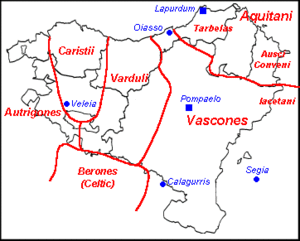Iruña-Veleia facts for kids

Veleia was an important Roman town in Hispania, which is now Spain. You can find its remains in the province of Álava, in the Basque Country. The site is about 10 kilometers west of Vitoria, near the town of Iruña de Oca.
Veleia was a key stop on a major Roman road called ab Asturica Burdigalam. This road ran along the coast of the Bay of Biscay. At its busiest, Veleia might have been home to about 5,000 to 10,000 people. The town saw times of growth and decline, lasting until the Early Middle Ages before it was finally left empty.
Some historians, like J.M. Lacarra, believe that the site of Iruña-Veleia is actually Victoriacum. This was a city founded by Liuvigild in 581 during his fights against the Vascones. This idea comes from the fact that only a small part of the ancient town has been dug up by archaeologists so far.
The archaeological site of Iruña-Veleia is the most important Roman site in the Basque Country. It became very famous because some amazing discoveries were announced there. These included what were thought to be the oldest writings in the Basque language. Also, a drawing of the crucifixion of Jesus, believed to be the oldest ever found, was announced. However, later on, it was said that these findings were fake. Other experts, though, still believed the items were truly ancient, matching the age found by the archaeologists who dug them up.
In June 2020, the archaeologist who announced these claims, Eliseo Gil, was found guilty of fraud. The court said that the items had been changed to make them look like they had old writings. This made them seem more valuable than they really were. Gil appealed this decision, but his appeal was turned down. He then appealed to a higher court. At the same time, experts are still debating whether the writings are real or not.
Contents
A Look at Veleia's History
From Bronze Age to Roman Times
The town of Veleia began around 800 BC, during the Late Bronze Age. The first houses here were rectangular or round. They had walls made of adobe (a type of mud brick) and roofs made of thatch. These houses were similar to others found nearby at a site called Atxa.
In the first half of the 1st century AD, some of these older houses were replaced. New ones were built in the Roman style, known as domus. This change to Roman architecture continued as the century went on.
Later Roman Period and Abandonment
We know more about Veleia in the later Roman period, around the 3rd and 4th centuries. During this time, the town started to show signs of decline. A wall was built around an area of about eleven hectares (about 27 acres). Veleia continued to exist into the 5th century, even after Roman power left the region. But by the end of that century, people were only using abandoned buildings for burials, and the town was eventually left empty.
Veleia in Modern Times
There was an abbey (a type of monastery) at the Veleia site from at least the 16th century. The buildings of this abbey could still be seen until the mid-19th century.
The Famous Discoveries
How the Findings Were Announced
The Iruña-Veleia site received a lot of money, about 3.72 million euros, from the Basque regional government. In 2006, the director of the archaeological dig announced some very exciting discoveries to the public.
These findings included what were thought to be the oldest non-name texts in the Basque language. This was seen as the first proof of written Basque. Also, there were announcements about drawings and writings on pieces of pottery. Some of these seemed to talk about Egyptian history and even had Egyptian hieroglyphs. Finally, the discovery of the earliest known drawing of the Calvary (the crucifixion of Jesus) was announced.
The Scientific Debate Begins
Because the findings were so unusual, the provincial government of Álava created a "Scientific Advisory Committee." This group was made up of nine university professors and other experts. Their job was to study the findings.
At a meeting in November 2008, almost all reports from the committee found problems with these special discoveries. The culture leader of Álava, Lorena Lopez de la Calle, called the situation the "biggest archaeological fraud in the history of the Iberian Peninsula". She also removed a museum official who had supported the findings. Later, one of the committee members, Julio Núñez, became the new director of the Iruña-Veleia excavations.
The Forgery Case in Court
The government of Álava decided to take legal action against those believed to be responsible for the possible fraud. Eliseo Gil, the archaeologist, has always said he is innocent. He believes his findings are real and has asked for scientific tests to prove it.
In June 2020, Eliseo Gil was found guilty of fraud. The court said that he or others working with him had changed the items. They made new marks on them to make them look like ancient writings. Gil appealed this decision, but the appeal was rejected. He then appealed to the Constitutional Court.
In August 2020, a group of 14 scientists wrote a letter in several Basque newspapers. They said that the question of whether the findings are fake is still a scientific debate. They argued that scientific questions should be solved by scientists in journals and conferences, not in courts. Many well-known archaeologists signed this letter.
See also
 In Spanish: Iruña-Veleia para niños
In Spanish: Iruña-Veleia para niños
- Basque language
- Caristii
- Autrigones
- Ab Asturica Burdigalam (the Roman road that ran through Veleia).
- Glosas Emilianenses
- Hand of Irulegi for the purportedly oldest text in Basque

